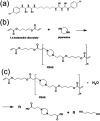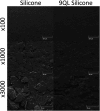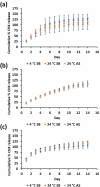A novel multilayer antimicrobial urinary catheter material with antimicrobial properties
- PMID: 39780948
- PMCID: PMC11701715
- DOI: 10.1039/d4ma01045k
A novel multilayer antimicrobial urinary catheter material with antimicrobial properties
Abstract
Urinary catheters are commonly used in medical practice to drain and monitor urine of patients. However, urinary catheterisation is associated with the risk of developing catheter-associated urinary tract infections (CAUTIs), which can result in life-threatening sepsis that requires antibiotics for treatment. Using the layer-by-layer (LbL) technique, we assembled a multilayer catheter comprising nine quadruple layers (9QL) of alginate, chlorhexidine (CHX), alginate and poly(β-amino ester) (PBAE) built upon an amino-functionalised silicone. The prepared catheter materials were tested for pre-packaged storage conditions and sterilisation techniques. The daily release of CHX was measured at pH 7.4 and pH 5 and simulated urine at 37 °C, which was used to determine the antimicrobial affect. CHX release was detected for a minimum of 14 days in PBS (pH 7.4), pH 5 release media, and simulated urine for the samples tested against storage conditions and sterilisation techniques. Incubation of the prepared material with bacterial cultures for 24 hours restricted bacterial growth compared to incubation with the standard material. The minimum inhibition concentration of CHX for clinically isolated urinary tract infection (UTI) bacterial strains was in the range of 19.4-77.4 µM, at which the released CHX could indirectly prevent bacterial growth for up to 14 days. Based on the daily CHX release from the samples, the hydrolysis of PBAE at pH 5 was gradual, resulting in a greater number of days of preventing bacterial growth, followed by pH 7.4 and then simulated urine. To the best of our knowledge, this is the first report on the use of PBAE in association with a urinary catheter material for the release of an antimicrobial drug.
This journal is © The Royal Society of Chemistry.
Conflict of interest statement
The authors declare no conflicts of interest.
Figures







Similar articles
-
Antifungal activity of a β-peptide in synthetic urine media: Toward materials-based approaches to reducing catheter-associated urinary tract fungal infections.Acta Biomater. 2016 Oct 1;43:240-250. doi: 10.1016/j.actbio.2016.07.016. Epub 2016 Jul 12. Acta Biomater. 2016. PMID: 27422198 Free PMC article.
-
Role of poly-beta-amino-esters hydrolysis and electrostatic attraction in gentamicin release from layer-by-layer coatings.J Colloid Interface Sci. 2018 Sep 15;526:35-42. doi: 10.1016/j.jcis.2018.04.042. Epub 2018 Apr 22. J Colloid Interface Sci. 2018. PMID: 29715613
-
Spray coating of foley urinary catheter by chlorhexidine-loadedpoly(ε-caprolactone) nanospheres: effect of lyoprotectants, characteristics, and antibacterial activity evaluation.Pharm Dev Technol. 2019 Apr;24(4):402-409. doi: 10.1080/10837450.2018.1502317. Epub 2018 Oct 22. Pharm Dev Technol. 2019. PMID: 30265590
-
Materials-based incidence of urinary catheter associated urinary tract infections and the causative micro-organisms: systematic review and meta-analysis.BMC Urol. 2024 Aug 30;24(1):186. doi: 10.1186/s12894-024-01565-x. BMC Urol. 2024. PMID: 39215290 Free PMC article.
-
Catheter-related urinary tract infection.Drugs Aging. 2005;22(8):627-39. doi: 10.2165/00002512-200522080-00001. Drugs Aging. 2005. PMID: 16060714 Review.
References
Grants and funding
LinkOut - more resources
Full Text Sources
